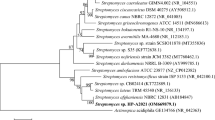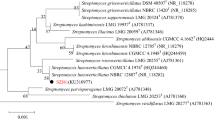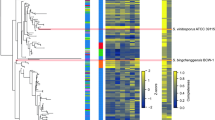Abstract
Streptomyces, and related genera of Actinobacteria, are renowned for their ability to produce antibiotics and other bioactive natural products with a wide range of applications in medicine and agriculture. Streptomyces coelicolor A3(2) is a model organism that has been used for more than five decades to study the genetic and biochemical basis for the production of bioactive metabolites. In 2002, the complete genome sequence of S. coelicolor was published. This greatly accelerated progress in understanding the biosynthesis of metabolites known or suspected to be produced by S. coelicolor and revealed that streptomycetes have far greater potential to produce bioactive natural products than suggested by classical bioassay-guided isolation studies. In this article, efforts to exploit the S. coelicolor genome sequence for the discovery of novel natural products and biosynthetic pathways are summarized.















Similar content being viewed by others
References
Barona-Gómez F, Wong U, Giannakopulos AE, Derrick PJ, Challis GL (2004) Identification of a cluster of genes that directs desferrioxamine biosynthesis in Streptomyces coelicolor M145. J Am Chem Soc 126:16282–16283
Barona-Gómez F, Lautru S, Francou FX, Leblond P, Pernodet JL, Challis GL (2006) Multiple biosynthetic and uptake systems mediate siderophore-dependent iron acquisition in Streptomyces coelicolor A3(2) and Streptomyces ambofaciens ATCC 23877. Microbiology 152:3355–3366
Bentley SD, Chater KF, Cerdeño-Tárraga AM, Challis GL, Thomson NR, James KD, Harris DE, Quail MA, Kieser H, Harper D, Bateman A, Brown S, Chandra G, Chen CW, Collins M, Cronin A, Fraser A, Goble A, Hidalgo J, Hornsby T, Howarth S, Huang CH, Kieser T, Larke L, Murphy L, Oliver K, O’Neil S, Rabbinowitsch E, Rajandream MA, Rutherford K, Rutter S, Seeger K, Saunders D, Sharp S, Squares R, Squares S, Taylor K, Warren T, Wietzorrek A, Woodward J, Barrell BG, Parkhill J, Hopwood DA (2002) Complete genome sequence of the model actinomycete Streptomyces coelicolor A3(2). Nature 417:141–147
Bentley SD, Brown S, Murphy LD, Harris DE, Quail MA, Parkhill J, Barrell BG, McCormick JR, Santamaria RI, Losick R, Yamasaki M, Kinashi H, Chen CW, Chandra G, Jakimowicz D, Kieser HM, Kieser T, Chater KF (2004) SCP1, a 356,023 bp linear plasmid adapted to the ecology and developmental biology of its host, Streptomyces coelicolor A3(2). Mol Microbiol 51:1615–1628
Bosello M, Mielcarek A, Giessen TW, Marahiel MA (2012) An enzymatic pathway for the biosynthesis of the formylhydroxyornithine required for rhodochelin iron coordination. Biochemistry 51:3059–3066
Cane DE, Watt RM (2003) Expression and mechanistic analysis of a germacradienol synthase from Streptomyces coelicolor implicated in geosmin biosynthesis. Proc Natl Acad Sci USA 100:1547–1551
Cerdeño AM, Bibb MJ, Challis GL (2001) Analysis of the prodiginine biosynthesis gene cluster of Streptomyces coelicolor A3(2): new mechanisms for chain initiation and termination in modular multienzymes. Chem Biol 8:817–829
Challis GL, Ravel J (2000) Coelichelin, a new peptide siderophore encoded by the Streptomyces coelicolor genome: structure prediction from the sequence of its non-ribosomal peptide synthetase. FEMS Microbiol Lett 187:111–114
Chater KF, Bruton CJ (1985) Resistance, regulatory and production genes for the antibiotic methylenomycin are clustered. EMBO J 4:1893–1897
Chemler JA, Buchholz TJ, Geders TW, Akey DL, Rath CM, Chlipala GE, Smith JL, Sherman DH (2012) Biochemical and structural characterization of germicidin synthase: analysis of a type III polyketide synthase that employs acyl-ACP as a starter unit donor. J Am Chem Soc 134:7359–7366
Chong PP, Podmore SM, Kieser HM, Redenbach M, Turgay K, Marahiel M, Hopwood DA, Smith CP (1998) Physical identification of a chromosomal locus encoding biosynthetic genes for the lipopeptide calcium-dependent antibiotic (CDA) of Streptomyces coelicolor A3(2). Microbiology 144:193–199
Corre C, Challis GL (2005) Evidence for the unusual condensation of a diketide with a pentulose in the methylenomycin biosynthetic pathway of Streptomyces coelicolor A3(2). ChemBioChem 6:2166–2170
Corre C, Song L, O’Rourke S, Chater KF, Challis GL (2008) 2-Alkyl-4-hydroxymethylfuran-3-carboxylic acids, antibiotic production inducers discovered by Streptomyces coelicolor genome mining. Proc Natl Acad Sci USA 105:17510–17515
Corre C, Haynes SW, Malet N, Song L, Challis GL (2010) A butenolide intermediate in methylenomycin furan biosynthesis is implied by incorporation of stereospecifically 13C-labelled glycerols. Chem Commun 46:4079–4081
Feitelson JS, Hopwood DA (1983) Cloning of a Streptomyces gene for an O-methyltransferase involved in antibiotic biosynthesis. Mol Gen Genet 190:394–398
Feitelson JS, Malpartida F, Hopwood DA (1985) Genetic and biochemical characterization of the red gene cluster of Streptomyces coelicolor A3(2). J Gen Microbiol 131:2431–2441
Funa N, Ohnishi Y, Fujii I, Shibuya M, Ebizuka Y, Horinouchi S (1999) A new pathway for polyketide synthesis in microorganisms. Nature 400:897–899
Funa N, Funabashi M, Yoshimura E, Horinouchi S (2005) A novel quinone-forming monooxygenase family involved in modification of aromatic polyketides. J Biol Chem 280:14514–14523
Funabashi M, Funa N, Horinouchi S (2008) Phenolic lipids synthesized by type III polyketide synthase confer penicillin resistance on Streptomyces griseus. J Biol Chem 283:13983–13991
Gomez-Escribano JP, Song L, Fox DJ, Yeo V, Bibb MJ, Challis GL (2012) Structure and biosynthesis of the unusual polyketide alkaloid coelimycin P1, a metabolic product of the cpk gene cluster of Streptomyces coelicolor M145. Chem Sci 3:2716–2720
Gottelt M, Kol S, Gomez-Escribano JP, Bibb M, Takano E (2010) Deletion of a regulatory gene within the cpk gene cluster reveals novel antibacterial activity in Streptomyces coelicolor A3(2). Microbiology 156:2343–2353
Gust B, Challis GL, Fowler K, Kieser T, Chater KF (2003) PCR-targeted Streptomyces gene replacement identifies a protein domain needed for biosynthesis of the sesquiterpene soil odor geosmin. Proc Natl Acad Sci USA 100:1541–1546
Gust B, Chandra G, Jakimowicz D, Yuqing T, Bruton CJ, Chater KF (2004) Lambda red-mediated genetic manipulation of antibiotic-producing Streptomyces. Adv Appl Microbiol 54:107–128
Haug I, Weissenborn A, Brolle D, Bentley S, Kieser T, Altenbuchner J (2003) Streptomyces coelicolor A3(2) plasmid SCP2*: deductions from the complete sequence. Microbiology 149:505–513
Haynes SW, Sydor PK, Stanley AE, Song L, Challis GL (2008) Role and substrate specificity of the Streptomyces coelicolor RedH enzyme in undecylprodiginine biosynthesis. Chem Commun 44:1865–1867
Haynes SW, Sydor PK, Corre C, Song L, Challis GL (2011) Stereochemical elucidation of streptorubin B. J Am Chem Soc 133:1793–1798
Hojati Z, Milne C, Harvey B, Gordon L, Borg M, Flett F, Wilkinson B, Sidebottom PJ, Rudd BA, Hayes MA, Smith CP, Micklefield J (2002) Structure, biosynthetic origin, and engineered biosynthesis of calcium-dependent antibiotics from Streptomyces coelicolor. Chem Biol 9:1175–1187
Hopwood DA, Wright HM (1983) CDA is a new chromosomally determined antibiotic from Streptomyces coelicolor A3(2). J Gen Microbiol 129:3575–3579
Hopwood DA, Malpartida F, Kieser HM, Ikeda H, Duncan J, Fujii I, Rudd BAM, Floss HG, Omura S (1985) Production of ‘hybrid’ antibiotics by genetic engineering. Nature 314:642–644
Hornemann U, Hopwood DA (1981) Biosynthesis of methylenomycin A: a plasmid-determined antibiotic. In: Corcoran JW (ed) Antibiotics IV. Springer, Berlin Heidelberg New York, pp 123–131
Hsiao NH, Söding J, Linke D, Lange C, Hertweck C, Wohlleben W, Takano E (2007) ScbA from Streptomyces coelicolor A3(2) has homology to fatty acid synthases and is able to synthesize gamma-butyrolactones. Microbiology 153:1394–1404
Imbert M, Bechet M, Blondeau R (1995) Comparison of the main siderophores produced by some species of Streptomyces. Curr Microbiol 31:129–133
Izumikawa M, Shipley PR, Hopke JN, O’Hare T, Xiang L, Noel JP, Moore BS (2003) Expression and characterization of the type III polyketide synthase 1,3,6,8-tetrahydroxynaphthalene synthase from Streptomyces coelicolor A3(2). J Ind Microbiol Biotechnol 30:510–515
Jiang J, He X, Cane DE (2007) Biosynthesis of the earthy odorant geosmin by a bifunctional Streptomyces coelicolor enzyme. Nat Chem Biol 3:711–715
Kadi N, Oves-Costales D, Barona-Gomez F, Challis GL (2006) A new family of ATP-dependent oligomerization-macrocyclization biocatalysts. Nat Chem Biol 3:652–656
Kempter C, Kaiser D, Haag S, Nicholson G, Gnau V, Walk T, Gierling KH, Decker H, Zähner H, Jung G, Metzger JW (1997) CDA: calcium-dependent peptide antibiotics from Streptomyces coelicolor A3(2) containing unusual residues. Angew Chem Int Ed Engl 36:498–501
Kirby R, Wright LF, Hopwood DA (1975) Plasmid-determined antibiotic synthesis and resistance in Streptomyces coelicolor. Nature 254:265–267
Krügel H, Krubasik P, Weber K, Saluz HP, Sandmann G (1999) Functional analysis of genes from Streptomyces griseus involved in the synthesis of isorenieratene, a carotenoid with aromatic end groups, revealed a novel type of carotenoid desaturase. Biochim Biophys Acta 1439:57–64
Kuczek K, Pawlik K, Kotowska M, Mordarski M (1997) Streptomyces coelicolor DNA homologous with acyltransferase domains of type I polyketide synthase gene complex. FEMS Microbiol Lett 157:195–200
Kuczek K, Mordarski M, Goodfellow M (1994) Distribution of oxoacyl synthase homology sequences within Streptomyces DNA. FEMS Microbiol Lett 118:317–325
Lautru S, Deeth RJ, Bailey LM, Challis GL (2005) Discovery of a new peptide natural product by Streptomyces coelicolor genome mining. Nat Chem Biol 1:265–269
Lautru S, Oves-Costales D, Pernodet JL, Challis GL (2007) MbtH-like protein-mediated cross-talk between non-ribosomal peptide antibiotic and siderophore biosynthetic pathways in Streptomyces coelicolor M145. Microbiology 153:1405–1412
Lin X, Hopson R, Cane DE (2006) Genome mining in Streptomyces coelicolor: molecular cloning and characterization of a new sesquiterpene synthase. J Am Chem Soc 128:6022–6023
Malpartida F, Hopwood DA (1984) Molecular cloning of the whole biosynthetic pathway of a Streptomyces antibiotic and its expression in a heterologous host. Nature 309:462–464
Malpartida F, Niemi J, Navarrete R, Hopwood DA (1990) Cloning and expression in a heterologous host of the complete set of genes for biosynthesis of the Streptomyces coelicolor antibiotic undecylprodigiosin. Gene 93:91–99
Micklefield J (2009) Biosynthesis and biosynthetic engineering of calcium-dependent lipopeptide antibiotics. Pure Appl Chem 81:1065–1074
Mo S, Kim BS, Reynolds KA (2005) Production of branched-chain alkylprodiginines in S. coelicolor by replacement of the 3-ketoacyl ACP synthase III initiation enzyme. RedP Chem Biol 12:191–200
Mo S, Sydor PK, Corre C, Alhamadsheh MM, Stanley AE, Haynes SW, Song L, Reynolds KA, Challis GL (2008) Elucidation of the Streptomyces coelicolor pathway to 2-undecylpyrrole, a key intermediate in undecylprodiginine and streptorubin B biosynthesis. Chem Biol 15:137–148
Nett M, Ikeda H, Moore BS (2009) Genomic basis for natural product biosynthetic diversity in the actinomycetes. Nat Prod Rep 26:1362–1384
O’Rourke S, Wietzorrek A, Fowler K, Corre C, Challis GL, Chater KF (2009) Extracellular signalling, translational control, two repressors and an activator all contribute to the regulation of methylenomycin production in Streptomyces coelicolor. Mol Microbiol 71:763–778
Patel P, Song L, Challis GL (2010) Distinct extracytoplasmic siderophore binding proteins recognize ferrioxamines and ferricoelichelin in Streptomyces coelicolor A3(2). Biochemistry 49:8033–8042
Pawlik K, Kotowska M, Chater KF, Kuczek K, Takano E (2007) A cryptic type I polyketide synthase (cpk) gene cluster in Streptomyces coelicolor A3(2). Arch Microbiol 187:87–99
Pawlik K, Kotowska M, Kolesiński P (2010) Streptomyces coelicolor A3(2) produces a new yellow pigment associated with the polyketide synthase Cpk. J Mol Microbiol Biotechnol 19:147–151
Petersen F, Zähner H, Metzger JW, Freund S, Hummel RP (1993) Germicidin, an autoregulative germination inhibitor of Streptomyces viridochromogenes NRRL B-1551. J Antibiot 46:1126–1138
Pohlmann V, Marahiel MA (2008) Delta-amino group hydroxylation of l-ornithine during coelichelin biosynthesis. Org Biomol Chem 6:1843–1848
Poralla K, Muth G, Härtner T (2000) Hopanoids are formed during transition from substrate to aerial hyphae in Streptomyces coelicolor A3(2). FEMS Microbiol Lett 189:93–95
Rudd BAM (1978) Genetics of pigmented secondary metabolites in Streptomyces coelicolor. University of East Anglia, Norwich
Rudd BAM, Hopwood DA (1979) Genetics of actinorhodin biosynthesis by Streptomyces coelicolor A3(2). J Gen Microbiol 114:35–43
Rudd BAM, Hopwood DA (1980) A pigmented mycelial antibiotic in Streptomyces coelicolor: control by a chromosomal gene cluster. J Gen Microbiol 119:333–340
Schupp T, Waldmeier U, Divers M (1987) Biosynthesis of desferrioxamine B in Streptomyces pilosus: evidence for the involvement of lysine decarboxylase. FEMS Microbiol Lett 42:135–139
Song L, Barona-Gomez F, Corre C, Xiang L, Udwary DW, Austin MB, Noel JP, Moore BS, Challis GL (2006) Type III polyketide synthase beta-ketoacyl-ACP starter unit and ethylmalonyl-CoA extender unit selectivity discovered by Streptomyces coelicolor genome mining. J Am Chem Soc 128:14754–14755
Stanley AE, Walton LJ, Kourdi Zerikly M, Corre C, Challis GL (2006) Elucidation of the Streptomyces coelicolor pathway to 4-methoxy-2,2′-bipyrrole-5-carboxaldehyde, an intermediate in prodiginine biosynthesis. Chem Commun 42:3981–3983
Sydor PK, Barry SM, Odulate OM, Barona-Gomez F, Haynes SW, Corre C, Song L, Challis GL (2011) Regio- and stereodivergent antibiotic oxidative carbocyclizations catalysed by Rieske oxygenase-like enzymes. Nat Chem 3:388–392
Sydor PK, Challis GL (2012) Oxidative tailoring reactions catalyzed by nonheme iron-dependent enzymes: streptorubin B biosynthesis as an example. Methods Enzymol 516:195–218
Takano E, Kinoshita H, Mersinias V, Bucca G, Hotchkiss G, Nihira T, Smith CP, Bibb M, Wohlleben W, Chater K (2005) A bacterial hormone (SCB1) directly controls the expression of a pathway-specific regulatory gene in the cryptic type I polyketide biosynthetic gene cluster of Streptomyces coelicolor. Mol Microbiol 56:465–479
Takano H, Obitsu S, Beppu T, Ueda K (2005) Light-induced carotenogenesis in Streptomyces coelicolor A3(2): identification of an extracytoplasmic function sigma factor that directs photodependent transcription of the carotenoid biosynthesis gene cluster. J Bacteriol 187:1825–1832
Thomas MG, Burkart MD, Walsh CT (2002) Conversion of l-proline to pyrrolyl-2-carboxyl-S-PCP during undecylprodigiosin and pyoluteorin biosynthesis. Chem Biol 9:171–184
Tsao SW, Rudd BAM, He XG, Chang CJ, Floss HG (1985) Identification of a red pigment from Streptomyces coelicolor A3(2) as a mixture of prodigiosin derivatives. J Antibiot 38:128–131
Tunca S, Barreiro C, Sola-Landa A, Coque JJ, Martín JF (2007) Transcriptional regulation of the desferrioxamine gene cluster of Streptomyces coelicolor is mediated by binding of DmdR1 to an iron box in the promoter of the desA gene. FEBS J 274:1110–1122
Wang CM, Cane DE (2008) Biochemistry and molecular genetics of the biosynthesis of the earthy odorant methylisoborneol in Streptomyces coelicolor. J Am Chem Soc 130:8908–8909
Whicher JR, Florova G, Sydor PK, Singh R, Alhamadsheh M, Challis GL, Reynolds KA, Smith JL (2011) Structure and function of the RedJ protein, a thioesterase from the prodiginine biosynthetic pathway in Streptomyces coelicolor. J Biol Chem 286:22558–22569
Wright LF, Hopwood DA (1976) Identification of the antibiotic determined by the SCP1 plasmid of Streptomyces coelicolor A3(2). J Gen Microbiol 95:96–106
Zhao B, Guengerich FP, Bellamine A, Lamb DC, Izumikawa M, Lei L, Podust LM, Sundaramoorthy M, Kalaitzis JA, Reddy LM, Kelly SL, Moore BS, Stec D, Voehler M, Falck JR, Shimada T, Waterman MR (2005) Binding of two flaviolin substrate molecules, oxidative coupling, and crystal structure of Streptomyces coelicolor A3(2) cytochrome P450 158A2. J Biol Chem 280:11599–11607
Zhao B, Lin X, Lei L, Lamb DC, Kelly SL, Waterman MR, Cane DE (2008) Biosynthesis of the sesquiterpene antibiotic albaflavenone in Streptomyces coelicolor A3(2). J Biol Chem 283:8183–8189
Acknowledgments
Funding from the BBSRC (EGH16081, B16610, BBSSK200310147, BB/S/B14450 and BB/E008003/1), the European Commission (Contract Nos. LSHM-CT-2004-005224 and MEIF-CT-2003-501686), the NIH (1R01GM77147-01A1), the Wellcome Trust, the EPSRC, the Royal Society and the Royal Society of Chemistry for S. coelicolor specialized metabolism research in the author’s laboratory is gratefully acknowledged. I am indebted to the many talented coworkers and collaborators, whose names appear in the reference section, for their contributions to research on S. coelicolor specialized metabolism. This article is dedicated to Prof. Sir David Hopwood on the occasion of his 80th birthday.
Author information
Authors and Affiliations
Corresponding author
Rights and permissions
About this article
Cite this article
Challis, G.L. Exploitation of the Streptomyces coelicolor A3(2) genome sequence for discovery of new natural products and biosynthetic pathways. J Ind Microbiol Biotechnol 41, 219–232 (2014). https://doi.org/10.1007/s10295-013-1383-2
Received:
Accepted:
Published:
Issue Date:
DOI: https://doi.org/10.1007/s10295-013-1383-2




